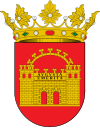Mérida, Spain
| Mérida | |||
|---|---|---|---|
| Municipality | |||

Collage of Mérida, Top:Merida Ancient Roman Theater, Second left:Asanblea de Extremadura (Extremadura Assembly), Second right:Acueducto de Los Milagros (Los Milagros Aqueduct), Third left:A interior of Merida National Roman Art Museum, Third upper right:Merida Roman Bridge, Third lower right:Tempo de Diana (Diana Temple), Bottom:A night view of Lusitania Bridge and Guadiana River
|
|||
|
|||
| Location in Spain | |||
| Coordinates: 38°54′N 6°20′W / 38.900°N 6.333°W | |||
| Country |
|
||
| Autonomous community |
|
||
| Province | Badajoz | ||
| Comarca | Mérida | ||
| Valley | Guadiana | ||
| Judicial district | Mérida | ||
| Founded | 25 BC | ||
| Government | |||
| • Mayor | Antonio Rodríguez Osuna (2015) (PSOE) | ||
| Area | |||
| • Total | 865.6 km2 (334.2 sq mi) | ||
| Elevation | 217 m (712 ft) | ||
| Population (2012) | |||
| • Total | 58,164 | ||
| • Density | 67/km2 (170/sq mi) | ||
| Demonym(s) | Emeritenses | ||
| Time zone | CET (UTC+1) | ||
| • Summer (DST) | CEST (UTC+2) | ||
| Postal code | 06800 | ||
| Website | Official website | ||
Mérida (Spanish pronunciation: [ˈmeɾiða]) is the capital of the autonomous community of Extremadura, western central Spain. The population was 58,164 in 2012. The Archaeological Ensemble of Mérida has been a UNESCO World Heritage site since 1993.
Mérida has a Mediterranean climate with Atlantic influences, due to the proximity of the Portuguese coast. The winters are mild, with minimum temperature rarely below 0 °C (32 °F), and summers are hot with maximum temperatures occasionally exceeding 40 °C (104 °F).
Precipitation is normally between 450 to 500 mm (17.7 to 19.7 in) annually. The months with most rainfall are November and December. Summers are dry, and in Mérida, as in the rest of southern Spain, cycles of drought are common, ranging in duration from 2 to 5 years.
In autumn the climate is more changeable than in the rest of the year. Storms occur with some frequency, but the weather is often dry.
Both humidity and winds are low. However, there is frequent fog, especially in the central months of autumn and winter.
Mérida has been populated since prehistoric times as demonstrated by a prestigious hoard of gold jewellery that was excavated from a girl's grave in 1870. Consisting of two penannular bracelets, an armlet and a chain of six spiral wire rings, it is now preserved at the British Museum. The town was founded in 25 BC, with the name of Emerita Augusta (meaning the veterans – discharged soldiers – of the army of Augustus, who founded the city; the name Mérida is an evolution of this) by order of Emperor Augustus, to protect a pass and a bridge over the Guadiana river. Emerita Augusta was one of the ends of the Vía de la Plata (Silver Way), a strategic Roman Route between the gold mines around Asturica Augusta and the most important Roman city in the Iberian Peninsula. The city became the capital of Lusitania province, and one of the most important cities in the Roman empire. Mérida preserves more important ancient Roman monuments than any other city in Spain, including a triumphal arch and a theatre.
...
Wikipedia



